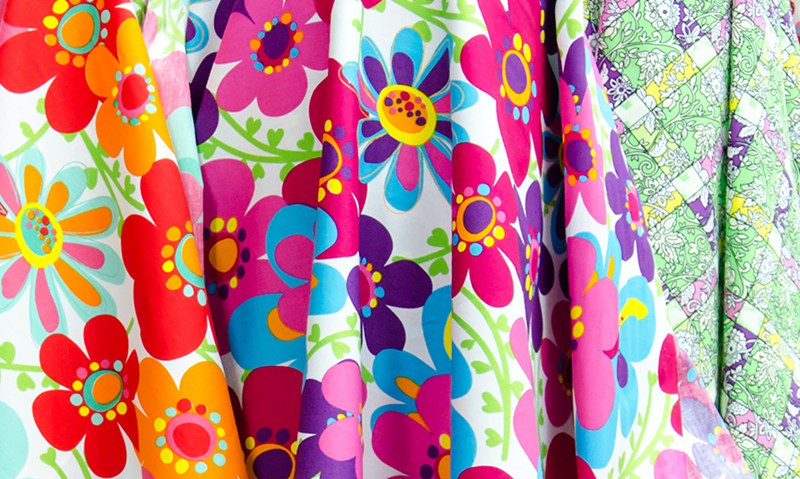
When learning about digital textile printing, beginners are often confused by the multitude of different technologies available today. The easiest way to understand the market and the associated ink technologies is to divide them into different segments by application:
* Banner printing
* Soft Signage
* Garment printing
* Roll-to-roll textile printing
These classification does not have strict boundaries, but they do overlap and determine the requirements needed for the inks and the technologies.
1. Banner Printing Inks
In many ways, digital printing of banners and flags might be considered the "predecessor" of soft signage. Since the 1990s, pioneering companies have tried to switch flag production from screen printing to digital printing.
For most countries and companies, the resolution is often not a problem; however, the durability of the sign can be problematic.
Most outdoor flags are made from polyester textiles. Today, they are usually printed using water-based direct disperse dye inks. When polyester is colored with disperse dye inks, the result may look a bit dull at first, as the colors require 170 °C to develop.
Direct printing disperse dye inks offer good show-through, which means that both sides of the flag appear colored. Outdoor durability is typically up to 3 years. This is why direct disperse ink technology is used in the automotive industry as well as for garden furniture.
Dye sublimation inks are also commonly used in the production of flags and banners. They are first printed on a very thin transfer paper. In the transfer sublimation process, when the transfer paper and polyester fabric are calendered together at 180 to 200 °C, the color is transformed from a solid to a gas phase without passing through an intermediate liquid phase. The color is then deeply embedded in the fibers.
Dye-sublimation inks print very sharp images and can be used to create small letters, suitable for printing soft signage. Show-through is much less than with direct disperse dye-sublimation inks. The durability of dye-sublimation prints is generally low.
2. Soft Signage Printing Inks
Soft signage are often printed onto textiles rather than paper, banner material, self-adhesive or mesh. The most commonly used inks are:
Dye inks
Latex inks
UV-curable inks
With the exception of sublimation inks, the inks used for indoor and outdoor soft signage are the same technology used for many other roll-to-roll and rigid applications and are therefore not textile specific.
3. Garment Printing Inks
Ever since the first 4C inkjet prints were available in copy shops, digital printing has been used to print shirts, hats and other garments. In the early days, the printer's output on thick sublimation foil was simply ironed or heat-pressed onto the item.
Today, sublimation ink solutions for garment printing are much more sophisticated. They still require polyester or polyester blends as a substrate or a polyester pre-coat. This is why sublimation inks are often used in sports fashion as well as numerous home furnishing applications such as cushions.
Sublimation inkjet printing technology works best with white light textiles. Today, water-based textile pigment inks are widely used for garment printing because they work with most fibers on the market. They print directly onto the product, so the technology is called "direct to garment" (DTG).
DTG inks are available in CMYK and opaque white, and they can also print on dark fabrics. They usually require pre-treatment and fixing in a heat press at about 160 °C. Epson, Brother, and Kornit Digital offer DTG printers in various sizes that use pigment inks.
4. Roll-to-roll Textile Printing Ink
Textile pigment inks are also very popular in the roll-to-roll digital textile printing because they can be printed on a wide range of fibers. Several pigment ink brands are OEKO-TEX certified, meaning they are suitable for children's clothes. In direct comparison with acid dye inks and reactive dye inks, prints using pigment inks appear duller. Since the color does not penetrate the fabric surface but is deposited on the fiber surface, while color fastness is generally good, wash fastness is sometimes lacking. Therefore, most experts recommend pigment inks for home decoration.
Industrial-level roll-to-roll digital textile printing occurs primarily in the textile industry. The two main water-based inks are reactive dye ink for cotton, wool, and nylon, and acid inks for silk, wool, or polyamide, require customized pre-treatment to achieve high-quality printing results. Post-treatment requires steaming to ensure that the dye is embedded in the fiber. Multiple washing cycles are required to remove excess ink. Acid dye ink and reactive dye ink offer vibrant colors, smooth hand-feeling, and good wash and light fastness, and are primarily used in fashion and high-end home decoration.
Conclusion
Today, a wide range of inkjet ink technologies are available to meet a wide range of digital textile printing needs. However, it is important to consider that, depending on the technology, pre- and post-processing will take a considerable amount of time. The necessary pre- and post-printing steps may require an increased investment that may exceed the price of the printer. Therefore, in-depth research is highly recommended.
 Nov 23,2024
Nov 23,2024
